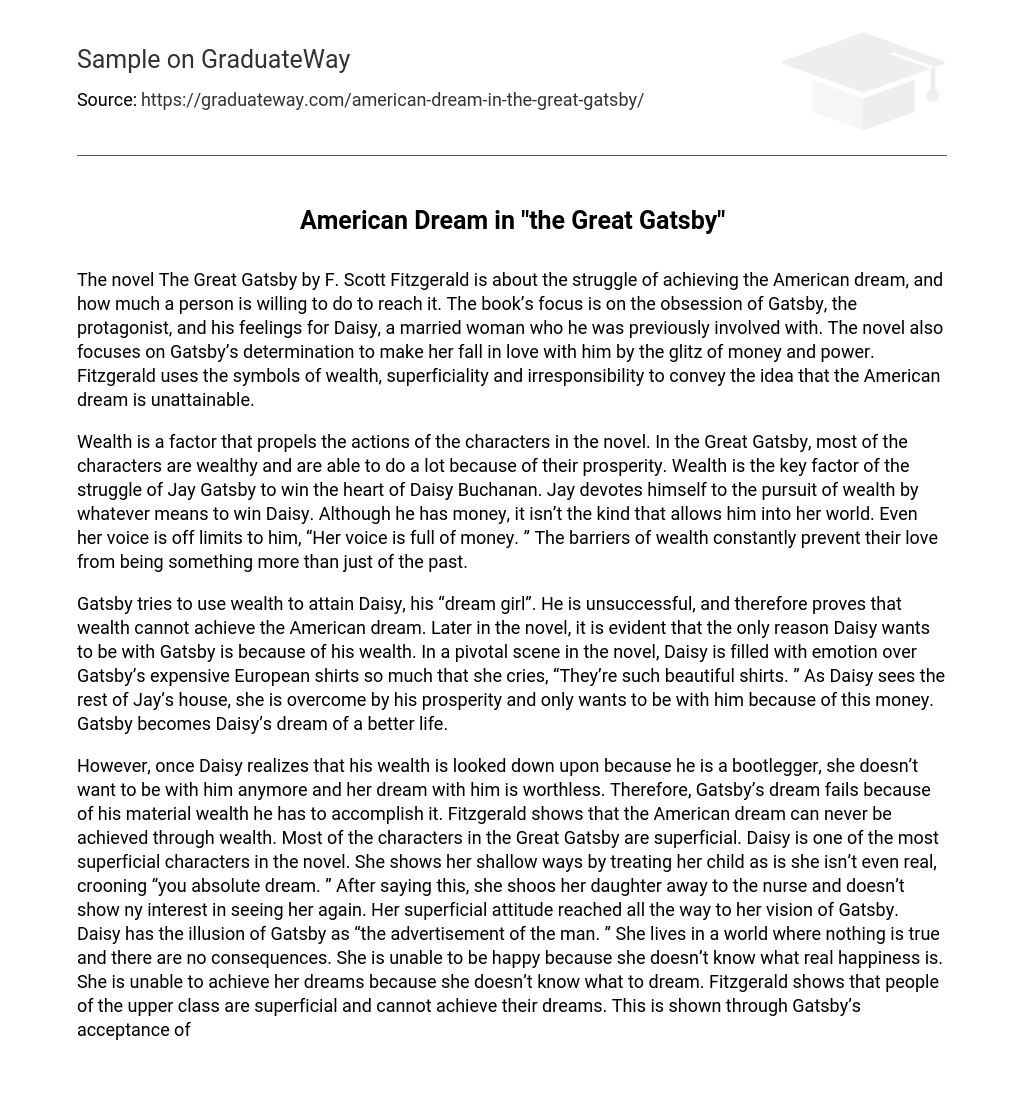The novel The Great Gatsby by F. Scott Fitzgerald explores the pursuit of the American dream and the extreme measures taken to attain it. The story revolves around Gatsby, who is deeply infatuated with Daisy, a married woman he had a previous relationship with. To win her love, Gatsby relies on his wealth and influence. Through the use of symbols such as wealth, superficiality, and recklessness, Fitzgerald implies that achieving the American dream is ultimately unattainable.
The characters in The Great Gatsby are heavily influenced by wealth, with most of them being affluent. This allows them to achieve many things. Jay Gatsby, in particular, is driven by the desire to win Daisy Buchanan’s heart and sees wealth as a crucial factor in his pursuit. He devotes himself to acquiring riches through any means necessary in order to impress Daisy. However, despite his abundance of money, he struggles to fully integrate into her world because his wealth is not the same type as hers. Even her voice, which embodies luxury – “Her voice is full of money” – remains beyond his grasp. The barriers created by their differing economic statuses continually hinder their love from blossoming into something more than just a memory.
In the novel, Gatsby attempts to use his wealth to win over Daisy, his dream girl. However, he ultimately fails and proves that money cannot buy the American dream. Later on, it becomes clear that Daisy is only interested in Gatsby because of his riches. This is shown in a significant scene where Daisy becomes emotional over Gatsby’s expensive European shirts and remarks, “They’re such beautiful shirts.” As she explores the rest of Jay’s extravagant home, she is consumed by his prosperity and desires him solely for his money. In this way, Gatsby becomes a symbol of a better life for Daisy.
Daisy discovers that Gatsby’s wealth is frowned upon due to his involvement in bootlegging. As a result, she no longer desires to be with him, rendering her dream of being together meaningless. Consequently, Gatsby’s dream ultimately falters as it relies on material riches for its realization. Fitzgerald effectively showcases that the American dream cannot solely be attained through wealth.
In The Great Gatsby, the majority of characters exhibit superficiality. Among them, Daisy stands out as one of the most superficial characters. She displays a disregard for her own child, referring to her as if she were not real and singing sweetly, “you absolute dream.” Following this comment, she sends her daughter away to be cared for by a nurse and does not express any desire to see her again. Daisy’s shallow mindset also applies to her perception of Gatsby, whom she sees solely as a symbol or representation. She exists in a realm where truth holds no value and where actions bear no consequences. Consequently, Daisy is unable to discover happiness or attain her dreams because she is unaware of what they truly are.
According to Fitzgerald, individuals belonging to the upper class lack depth and struggle to genuinely pursue their aspirations. This can be observed when Gatsby agrees to attend Mrs. Sloane’s party despite it being insincere.
Expressing his disapproval of Gatsby’s misjudgment and comments, Tom Buchanan believes that “My God, I truly think this man is coming… doesn’t he realize that she does not want him?”
In the novel, all characters have had dreams but were unable to achieve them because they lacked authenticity and honesty towards others. To live a fulfilling life, one must show kindness to receive it in return. Fitzgerald uses superficial attitudes and behaviors to show that the American dream is impossible. The characters are misguided about their actions’ consequences and fail to take responsibility for their unethical choices.
The individuals in the novel engage in constant outings, party attendance, and participation in illegal actions such as prohibited alcohol consumption. The symbol of lack of responsibility is exemplified through the presence of automobiles. These vehicles epitomize the reckless behavior exhibited by the characters and serve as a significant factor contributing to the tragic events of the storyline. The destructive nature of automobiles is initially showcased at Gatsby’s party, where a car that departed mere moments earlier violently crashes, with one of its wheels lost. This event prefigures the impact that automobiles will have on the characters as the narrative progresses.
Irresponsibility results in the demise of the American dream for the characters. Myrtle Wilson desires to be with Tom as her American dream, but her carelessness and lack of intelligence ultimately lead to her being hit and killed by a car after running in front of it. Daisy, who was driving the car, manages to escape the repercussions of her actions by using Gatsby as a shield and failing to take responsibility. This, in turn, causes Gatsby’s dream of being with Daisy to fall apart. F. Scott Fitzgerald incorporates the decline of American values through Gatsby’s unsuccessful pursuit of his dream.
The Great Gatsby showcases characters as exemplifications of the message that the original American dream and its notions of purity have been supplanted by wealth, shallowness, and recklessness. Daisy embodies shallowness and is linked to the green light, which signifies hope, money, and envy. At the heart of the American dream lies hope, while money, shallowness, and recklessness encompass it. Consequently, Daisy becomes ensnared in her own inability to attain her American dream and is burdened with nothing but guilt and remorse following Gatsby’s demise.





